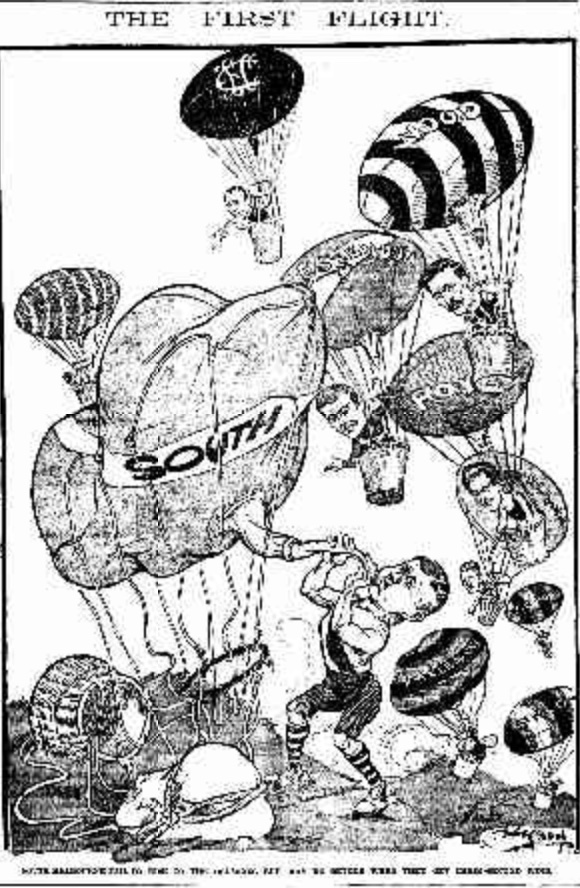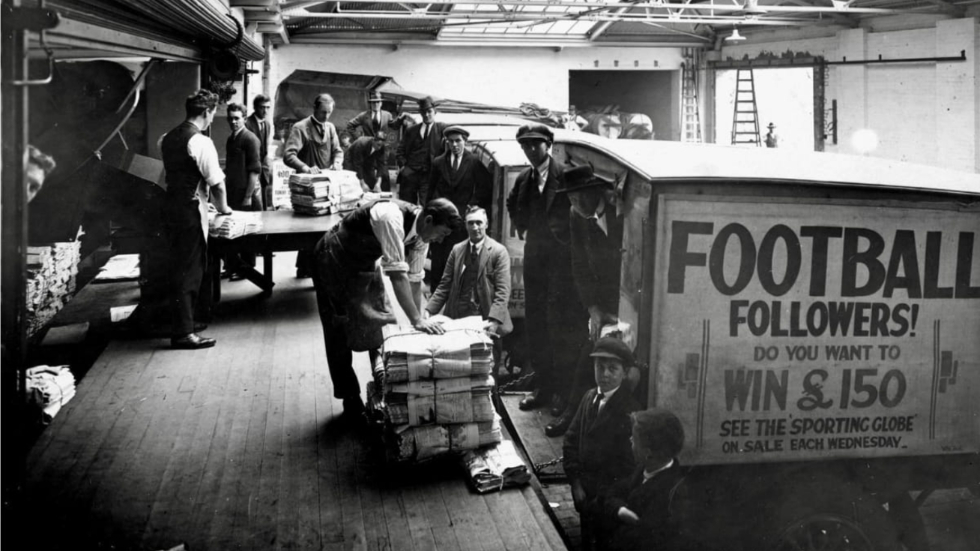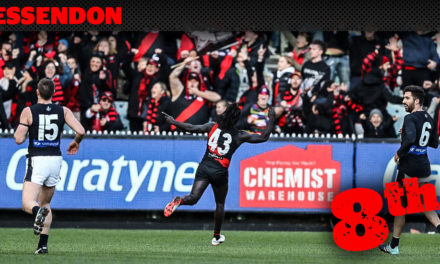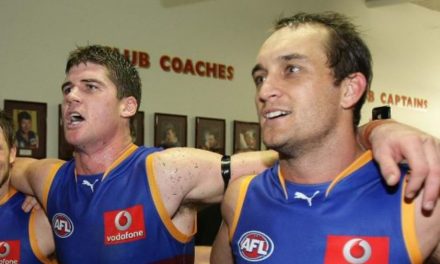Papers being loaded into delivery trucks at the old Herald and Weekly Times building in 1923. Photo: HERALD SUN.
I have a major issue with the Australian Football Hall of Fame. Unlike most of these debates, however, this one isn’t about a player or coach.
I believe a journalist of inestimable importance, Tom “Kickero” Kelynack, is missing from the Hall of Fame; he has been snubbed, and someone else is sitting in his place.
Yes, I know the Hall of Fame inflames controversy; its yearly intake is a tight squeeze, and barrackers rage when their favourite players miss out. But if you think induction is tough for champion footballers, try getting into the Hall of Fame’s media section.
Master commentator Dennis Cometti was its last inductee, in 2018, but he is one of just 10 media representatives. That doesn’t do justice to the press-football relationship that dates to the code’s 1850s birth. And it’s Kelynack, who should sit atop their list of additions.
From the 1890s to 1930, Tom Kelynack (or Kickero, as his byline read) was Melbourne’s supreme football newspaperman. Importantly, “The Herald” football department he oversaw celebrated and glorified Australian rules football.
In contrast, during the very same decades, “The Argus” and “The Age” preferred cricket and horse racing and only tolerated Australian rules as if it were an upstart stepchild.
Footy fans trusted Kelynack to mediate football’s biggest concerns, as the players, coaches, club and VFL officials all confided in him, knowing he would treat them with respect and consideration. He was formally honoured by the VFL before his 1930 retirement, and afterwards by the National Football Council, but induction into the Australian Football Hall of Fame, established in 1996, is long overdue, as is a full explanation of his legacy.
The earliest representative in the Hall of Fame’s media contingent is Essendon premiership footballer Reginald Wilmot. For 40 years post his playing days, Wilmot presided over The Argus’s football department; decades identical to Kelynack’s Herald years.
As the only Hall of Fame representative from that time, looking back today we could assume that Wilmot had been his era’s voice of football, but extensive reading of early 20th century newspapers, via their easy access on the National Library of Australia’s online Trove database, does not support that assumption.
It is my contention that the wrong person is sitting in the Hall of Fame, that it was Kelynack, and not Wilmot, who gave Australian rules the greater service.
I don’t seek to denigrate Wilmot, nor get him thrown out, he spent decades pondering over football for The Argus, but the opposition Herald during the same time-period was vastly superior, and its football delivery was ground-breaking.

The illustrated “FOOTBALL” banner which graced ‘Kickero’s’ Friday football coverage in The Herald
The bigger-selling Argus and Age confined football solely to their Monday editions, with drab, under-researched, inaccurate match summaries, positioned uninvitingly beneath banal headlines and editorials. Their football commitments were hard to locate, being neither near the front nor the back of the paper; and indistinguishable alongside the Shipping News or Commercial Intelligence.
For reasons unknown, the Age and Argus stuck to these similar, outdated, paltry football offerings from the 1870s until the 1930s. Their lofty indifference to Australian rules football blinded them from embracing the sporting phenomenon unfolding on their own doorstep, while Kelynack and his Herald were revelling in it.
From the onset, Kelynack saw what football coverage could be. He knew well the enormity of the code in Victoria and the style of press it warranted. Rejecting the caustic and judgemental tone of his opposition, he wrote about footy with a sense of wonder.
He gathered snippets of incidental happenings, news and gossip, from across clubs and competitions via his quickly established reservoir of contacts, and combined all that into a weekly football-dedicated column. Previously, football snippets were irregular, and randomly placed, and no newspaper provided football news daily.
It is hard for Melburnians to imagine a time when their papers may have had a paragraph or two on footy matters one day, only for next few days to have none. Kelynack’s same page and same place footy column recorded the happenings of not just the dominant 1890s VFA teams, but the many blossoming metropolitan and rural leagues.
He presented news of exciting recruits, player walkouts, injury updates, the exploits of adored ex-champions, committee jostling, the opinions of those in the know, social events, rule changes, umpiring concerns, administrative decisions, and whatever else was deemed to be of interest.
His initial 1888 allocation of a mere column soon expanded to five or six columns, about half-a-page, through the 1890s; and it maintained healthy column growth for several more decades.
To best describe its significance, previously, a report of the death of a pioneering footballer was easily overlooked, as nobody was certain as to where such information would appear. The one or two paragraph report would have been randomly inserted somewhere on a middle page, mixed within general non-sport news items, on no particular day.
PLEASE HELP US CONTINUE TO THRIVE BY BECOMING AN OFFICIAL FOOTYOLOGY PATRON. JUST CLICK THIS LINK.
Kelynack paid it more respect, placing that report in his Friday footy feature which went beyond just being a one-stop-shop for news and information. Kelynack’s Friday feature heavily promoted and built anticipation for the next day’s matches; priceless publicity the VFL lapped up.
If news and gossip gave Kelynack his first innovation, the second emanates from his primal use of imagery. Better historians than me have written of a Melbourne press belief that football was the domain of the lesser elements of society, a lowly-educated mass that only wanted to read about match scores and ladder positions. Kelynack was having none of that.
By 1909, The Herald’s Friday evening football feature towered over any other football offering, anywhere. It filled 11 columns, more than one full page, when the bigger selling Age and Argus gave football just three columns of match summaries, once a week.
Kelynack’s full-page footy feature was lit up by two magnificent works of art, an illustrated “FOOTBALL” banner, and an even larger cartoon, when cartoons did not exist anywhere in the Melbourne press. Over 100 years later, these Friday features survive as visually stunning, highly-collectible, rich cultural texts.
The topical cartoons were sketched by famous Australian literary figures like Hal Gye, the illustrator of the C.J. Dennis Australian literary classic “The Sentimental Bloke”, and Will Dyson, who later enjoyed large scale international acclaim as a political and First World War cartoonist.
The cartoons poke fun at everyday Melburnians going about their business, under the heavy influence of football. The rich are lampooned, as are the poor, the educated, the politician, the policeman, the priest, the servant, the labourer.
The combination of absurd imagery and witty script invited so-called disinterested football readers to mull over professionalism, gambling, umpiring, administration, gender, status, nationalism, celebrity, larrikinism, rough play, the fan experience, and more.
For the first time a Melbourne newspaper took pride in the deep societal and cultural penetration of football into Victoria, and again, the visionary Kelynack’s use of visual imagery predates how we now expect football to be presented.
Additionally, the 100-plus published football Herald cartoons have captured the mind-boggling array of inventions and discoveries of the early 20th century. The nascent technologies of bi-planes, zeppelins, cars, buses, motorcycles, photography, and telecommunications, as well as maritime and scientific breakthroughs, frame the narrative of many cartoons.

A cartoon from The Herald’s Friday football coverage.
Sadly, within just a few years the advancements of those technologies, and sciences, saw them become instruments of war. And the First World War would have a destructive effect on football reporting.
Kelynack saw his footy feature shrink, then disappear, until the early 1920s. The glorious football cartoons never returned. When the war began to drag on, when the horrors of Gallipoli were realised, all three daily papers became hostile to Australian rules football. But that is a story for another day.
Few people are likely aware that the “Football Record” was Kelynack’s idea. There is some confusion as to how the Record began, as it is most often noted as being a booklet to list player jumper numbers.
Numbers were first sewn on jumpers and listed on the scoreboard during the 1911 finals series. Commercial enterprises, however, had acted quickly on their introduction, and sold cards that promoted their businesses, and listed the players numbers, near to the stadiums on match days.
Kelynack recommended to the VFL that printer George Cathie produce an official VFL match program and have it sold beside the entrance gates, banishing the rogue sales. It could also attract both advertising income and sales revenue. The VFL jumped on the idea and it immediately proved financially viable.
The Cathie family would print and produce the Football Record for the VFL from 1912 until 1961. More significantly, and more grounded to Kelynack’s initial intent, the Football Record unwaveringly promoted football, and gave ample space for the VFL to write its own spin, because the VFL was sick and tired of the lamentable, once-a-week, pious offerings of the local press. Especially when horse racing dominated the sports pages.
In 1935, the VFL honoured Reginald Wilmot for his services to journalism by presenting him a mahogany box. This was the second such award. The first had already been presented to Tom ‘Kickero’ Kelynack.
In press articles at the time of Reg Wilmot’s retirement, his love for cricket and school sport shone through. Football wasn’t an obsession for him, just part of a greater love of sport. He had mostly been helpful to Australian rules, but nothing in comparison to what Kelynack did.
It was a contribution that demands more acknowledgement. And if the Hall of Fame is to accurately reflect the contribution of media to the game of Australian football, it is a no-brainer that Kelynack, or ‘Kickero’, as his byline read, simply must be made a member.












Absolutely correct on this Andrew, Kickero is an obvious candidate for the Hall of Fame, he was pivotal in promoting the game and establishing football traditions we take for granted, round up from around the clubs, tips from expert panels and more. Just another example of the Hall of Fame/AFL neglect of the game’s history, especially the early years.
Interesting reading. Thank you. If he was the starting point for The Football Record then he should get in based on that alone…surely!
1890s to 1930s – that is a long run and a big contribution. Is there a photograph of Kickero somewhere?
A great read Andrew … I’ve always found Kickero’s fascinating with his open minded reporting of our great game … he is an incredible omission from the AFL Hall of Fame …